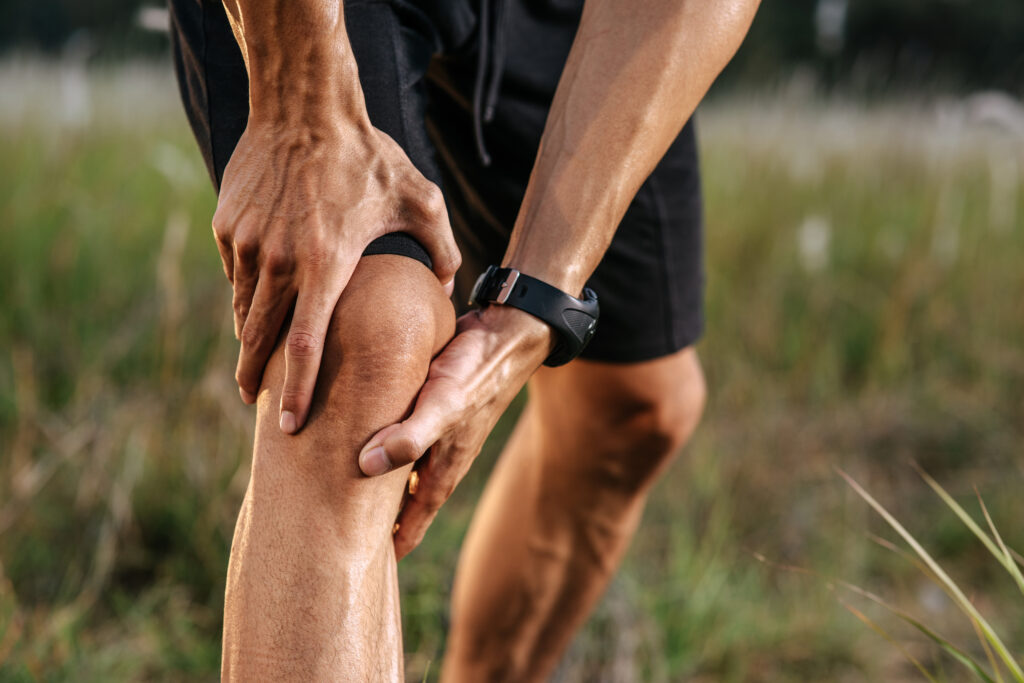If you're looking to improve your joint flexibility and movement, you've come to the right place. You might not realize how much simple changes to your routine can make a significant difference. For instance, incorporating dynamic stretching into your warm-up or maintaining proper hydration can set the stage for better performance. But that's just the beginning. There are several additional strategies you can employ that could transform your approach to flexibility. Let's explore these tips and uncover how each one can contribute to your overall mobility.
Incorporate Dynamic Stretching
Many people overlook the importance of dynamic stretching when it comes to enhancing joint flexibility. You might think static stretching is enough, but incorporating dynamic stretches into your routine can greatly improve your flexibility and range of motion. Dynamic stretching involves moving parts of your body through their full range of motion and is particularly beneficial before workouts or physical activities.
Start by integrating dynamic stretches into your warm-up. For instance, leg swings can help loosen up your hips, while arm circles prepare your shoulders for action. Perform these movements in a controlled manner, aiming for 10 to 15 repetitions per side. You'll not only elevate your heart rate but also activate the muscles and joints you'll rely on during your workout.
Another effective dynamic stretch is lunges with a twist. As you step forward into a lunge, rotate your torso towards the forward leg. This helps to engage your core while stretching your hip flexors and spine. Incorporating exercises like high knees or butt kicks can also elevate your body temperature and prepare your muscles more effectively than static stretches alone.
Remember to listen to your body. If a particular dynamic stretch feels uncomfortable, adjust your range of motion or try a different variation.
Practice Yoga Regularly
Incorporating dynamic stretching into your routine sets a solid foundation for improving flexibility, but practicing yoga regularly can take your joint mobility to the next level.
Yoga combines strength, balance, and flexibility, allowing you to work on multiple aspects of your physical health simultaneously. As you flow through various poses, you'll engage different muscle groups, helping to increase your range of motion and improve overall joint function.
Start with beginner-friendly classes or online tutorials if you're new to yoga. Focus on poses that emphasize hip openers and spinal twists, like Downward Dog, Warrior II, and Pigeon Pose. These positions won't only enhance flexibility but also strengthen the muscles surrounding your joints, providing better support.
Try to practice at least two to three times a week to see noticeable improvements. Consistency is key, so consider setting aside specific times for your sessions. You don't need to spend hours on the mat; even 20 to 30 minutes can make a significant difference.
As you progress, challenge yourself with more advanced poses that require deeper stretching and balance, like Crow Pose or King Pigeon Pose.
Always listen to your body; it's important not to push yourself too hard and risk injury.
Use Foam Rollers
Foam rollers are a fantastic tool for enhancing joint flexibility and relieving muscle tension. By incorporating foam rolling into your routine, you can effectively target tight muscles and fascia, which often contribute to restricted movement and discomfort.
When you roll over your muscles, you're applying pressure that helps break down knots and improve blood flow, ultimately aiding in recovery and flexibility.
To get started, find a flat surface and choose a foam roller that suits your needs. Generally, a medium-density roller is a great option for beginners.
Start by lying on the roller, positioning it under the muscle group you want to target, such as your calves, thighs, or back. Slowly roll back and forth for 30 seconds to a minute, pausing on any particularly tight spots to allow the pressure to release the tension.
You can also incorporate different techniques, like cross-fiber rolling, which involves rolling perpendicular to the muscle fibers. This method can help improve the tissue quality and enhance flexibility even further.
Don't forget to breathe deeply while rolling; it helps you relax and allows the muscles to release tension more effectively.
Aim to foam roll several times a week, especially before and after workouts. This practice won't only aid in muscle recovery but also keep your joints moving freely.
As you become more comfortable with foam rolling, you'll likely notice improvements in your overall flexibility and mobility, making it an invaluable part of your fitness routine.
Stay Hydrated
Staying hydrated is essential for maintaining joint flexibility and overall health.
You should aim to drink enough water throughout the day and incorporate water-rich foods into your meals.
Timing your hydration, especially before and after exercise, can make a big difference in how your joints feel.
Importance of Hydration
Hydration plays an essential role in maintaining your joint flexibility and overall mobility. When you're well-hydrated, your joints are better lubricated, reducing friction and allowing for smoother movement. This lubrication is vital for preventing stiffness and discomfort, especially during physical activities.
Dehydration can lead to decreased synovial fluid, which cushions your joints. This reduction can cause increased wear and tear on the cartilage, leading to pain and reduced range of motion. By drinking enough water throughout your day, you can support your joints and maintain their health, making it easier to move freely and engage in your favorite activities.
To guarantee you're properly hydrated, aim for at least eight glasses of water a day, but adjust based on your activity level and climate. Listen to your body; if you feel thirsty or notice darker urine, it's a sign you need to drink more.
Incorporating hydration into your daily routine doesn't have to be a chore. Keep a water bottle handy, set reminders, or infuse your water with fruits for added flavor.
Staying hydrated is a simple but powerful step toward enhancing your joint flexibility and overall physical performance.
Water-Rich Foods
Incorporating water-rich foods into your diet can greatly boost your hydration levels and support joint flexibility. Foods like cucumbers, watermelon, oranges, and celery aren't only invigorating but also packed with essential nutrients. When you eat these, you're getting a double benefit—hydration and crucial vitamins and minerals.
Aim to include a variety of these foods in your meals and snacks throughout the day. For instance, start your morning with a smoothie made from spinach, pineapple, and coconut water for a hydrating kick. At lunch, toss some juicy tomatoes and crisp lettuce into your salad, and for dinner, consider a side of steamed broccoli or zucchini.
Snacking on fruits like strawberries or grapes can also be an enjoyable way to stay hydrated. Remember, even soups and broths can contribute to your daily water intake.
Hydration Timing Strategies
Timing your hydration throughout the day can greatly impact how your joints feel and function. To maximize joint flexibility, aim to drink water consistently rather than chugging large amounts at once. Start your day with a glass of water as soon as you wake up. This kickstarts your hydration and helps lubricate your joints after a night of rest.
During your workouts, sip water regularly to maintain fluid levels and prevent dehydration. If you're exercising intensely or for longer durations, consider incorporating electrolyte-rich drinks to replenish lost minerals. Post-workout, hydrate to aid recovery and reduce stiffness.
Throughout the day, set reminders to drink water, especially if you often forget. Carry a reusable water bottle with you; it's a simple way to encourage regular sipping. Aim for at least eight 8-ounce glasses of water daily, adjusting based on your activity level and climate.
Finally, pay attention to your body's signals. If you feel thirsty, that's a clear sign to hydrate. Prioritize your hydration timing, and you'll likely notice improved joint health and flexibility, making daily movements easier and more enjoyable.
Warm Up Properly
Before diving into any workout, it's vital to warm up properly to prepare your joints and muscles for the activity ahead. A well-structured warm-up increases blood flow, enhances flexibility, and reduces the risk of injury. You don't want to jump straight into intense movements without giving your body the chance to adjust.
Start your warm-up with light aerobic activities, like brisk walking or cycling, for about five to ten minutes. This increases your heart rate and gets the blood circulating, which is essential for joint mobility.
Once you've warmed up your body, move on to dynamic stretches. These are more effective than static stretches because they involve movement, helping to improve your range of motion and activate the muscles you'll be using. Incorporate movements that mimic the exercises you'll perform later. For example, if you're planning on running, perform leg swings and high knees. This not only prepares your joints but also engages the specific muscle groups, making your workout more effective.
Don't forget to pay attention to your body during the warm-up. If something feels tight or uncomfortable, spend extra time on that area. You might include foam rolling or gentle mobility exercises to target specific joints that need more attention.
Focus on Strength Training
Strength training is essential for maintaining joint flexibility and overall mobility. When you build strength in the muscles surrounding your joints, you create a supportive framework that stabilizes and protects them. This stability not only enhances your performance in daily activities but also reduces the risk of injury.
Incorporate exercises that target all major muscle groups, focusing on areas such as the legs, core, and upper body. Movements like squats, lunges, and deadlifts engage multiple joints, promoting better coordination and flexibility. Using free weights or resistance bands can also add variety and intensity to your workouts, guaranteeing you're effectively challenging your muscles.
It's important to maintain proper form during strength training. When you perform exercises incorrectly, you could place undue stress on your joints, ultimately hindering flexibility rather than enhancing it. Consider working with a trainer or watching instructional videos to guarantee you're executing movements safely and effectively.
Don't forget to include a range of motion in your strength training routine. Exercises like push-ups or tricep dips not only build strength but also encourage joint mobility. As you progress, aim to gradually increase the resistance or weight you use. This progressive overload helps your muscles adapt and grow stronger, leading to improved joint function.
Ultimately, by focusing on strength training, you're investing in the longevity of your joints and enhancing your overall physical performance. You'll feel more agile and capable, ready to tackle whatever challenges come your way.
Maintain Consistent Practice
Building strength isn't a one-time effort; it requires consistent practice to truly enhance your joint flexibility. If you want to see real improvements, you need to commit to a regular routine. This doesn't mean you have to spend hours in the gym every day; instead, focus on incorporating flexibility exercises into your weekly schedule. Aim for at least three to four sessions per week, dedicating time to both strength and flexibility training.
During each session, prioritize quality over quantity. Rather than rushing through exercises, concentrate on your form and control. This approach not only helps prevent injuries but also guarantees that you're effectively targeting the muscles and joints involved. Remember, slow and steady wins the race.
You can also keep things interesting by varying your routine. Try different stretches or exercises to challenge your body and prevent boredom. Whether it's yoga, Pilates, or resistance training, mixing up your activities will keep you engaged and motivated.
Don't forget to listen to your body. If something doesn't feel right, adjust your routine. Consistent practice doesn't mean pushing through pain; it's about finding the right balance between challenge and comfort.
Finally, track your progress. Maintaining a journal or using an app can help you stay accountable and motivated. Celebrate your achievements, no matter how small, as they'll encourage you to continue your journey toward enhanced joint flexibility and movement.
Stay committed, and you'll reap the benefits.
Conclusion
By incorporating these tips into your routine, you'll boost your joint flexibility and overall movement. Remember to include dynamic stretching and yoga, use foam rollers, and stay hydrated. Always warm up properly and focus on strength training to support your flexibility goals. Most importantly, maintain consistent practice, and you'll see progress over time. Keep pushing yourself, and enjoy the benefits of increased flexibility and improved performance in your favorite activities!



